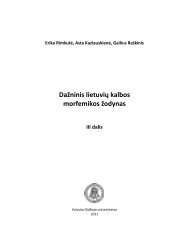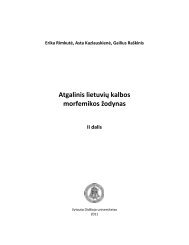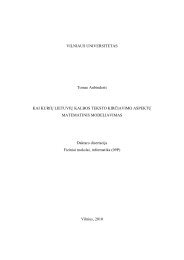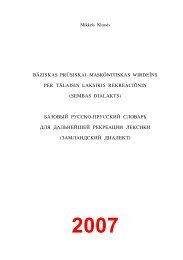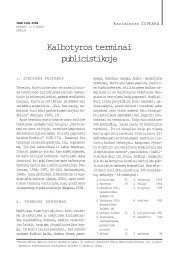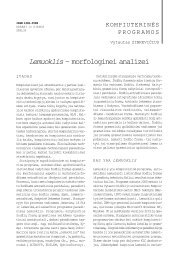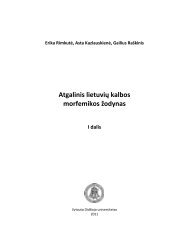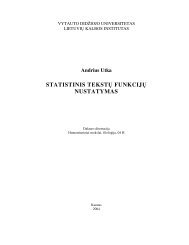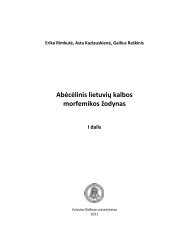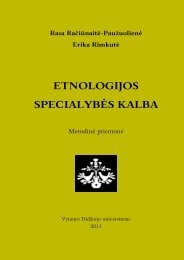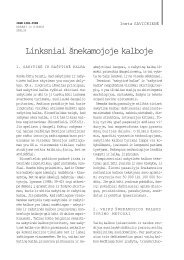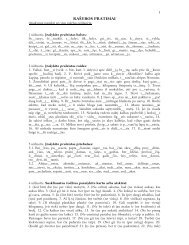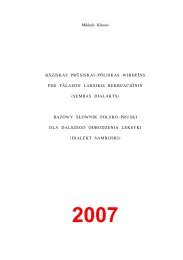HISTORICAL GRAMMAR OF OLD PRUSSIAN
HISTORICAL GRAMMAR OF OLD PRUSSIAN
HISTORICAL GRAMMAR OF OLD PRUSSIAN
Create successful ePaper yourself
Turn your PDF publications into a flip-book with our unique Google optimized e-Paper software.
<strong>HISTORICAL</strong> <strong>GRAMMAR</strong> <strong>OF</strong> <strong>OLD</strong> <strong>PRUSSIAN</strong><br />
*-ai /*-ei, in which Pr. adv. *-ei (qu-ei ‘where’) originates in its turn, cf.<br />
Lith. -i…e (nam-i…e, or-i…e), cf. BS 127 ff., Rosinas Baltistica XXXIV 179 37 .<br />
An opinion that the inflection -ai in the first part of the compound<br />
sallubai busennis (III) is locative (Endzelîns SV 58 f.), seems to be doubtful<br />
(cf. PEÞ IV 51 f. s.v. sallubai).<br />
* 96. Nom. pl. masc. Balt. *-ai > Pr. *-ai, cf.: wijrai (III) ‘men’,<br />
tawai (III, voc. pl.) ‘fathers’, grîkai (III) ‘sins’. The same Pr. -ai is reflected<br />
in pallapsaey (II 5 , I 5 ) ‘commandments’ with an accented final<br />
1 1<br />
circumflex *-ãi rendered as -aey (i.e. reflecting a lenthened first component<br />
of the diphthong, cf. PEÞ III 215, as well as * 4). For the a-stem (i.e.<br />
a/e-stem) inflection Balt. (pron. adj.) *-ei cf. BS 170 ff., as well as * 164.<br />
* 97. Nom.(-acc.) pl. neut. inflection is usually seen (due to<br />
OSl. nom.-acc. pl. neut. vrat-a < IE *-`) in Pr. (E) warto ‘door’ (e.g.<br />
Endzelîns SV 59, Stang Vergl. Gr. 301) with Pr. (E) -¯É = *-`. Nevertheless<br />
it is not easy to say whether there still existed an a-stem neutral<br />
plural form of nominative-accusative in the time of (E) in Prussian, or it<br />
had already turned into a collective noun, i.e. into an `-stem feminine<br />
singular form, cf. PEÞ IV 226 f. The same should be said about Pr. (E)<br />
slayo ‘sledge’, cf. PEÞ IV 126 f. (s.v. slayan) and bibliography 38 . In spite<br />
even in separate dialects” (ibid. p. 178). However Common Indoeuropean was not any “standard<br />
Latin” but a sum of related dialects. The same is true for Common Baltic. Thus WBaltic<br />
and EBaltic were independent dialects of late Indoeuropean (WBaltic shared some isoglosses<br />
with Slavic and not shared them with EBaltic). Therefore, the “secondary cases”, including<br />
the paradigmatic locative, were formed in EBaltic separately, as it has been showed in BS – cf.<br />
e.g. “loc.” Pr. (bît)-ai /= Lith. *-ei in (nam)-ie. Rosinas, ibid. p. 178–180, applies B. Comrie’s<br />
and S. Lauraghi’s rules of syncretism of cases to an epoch when cases were on the initial stage<br />
of formation. – L.P.<br />
38 In spite of predicative neutral adjectives (used adverbially) and neuter-gender pronouns,<br />
there is no grammatical neuter gender in Eastern Baltic. The presence of this gender in Prussian<br />
(as well as orientation toward traditional comparative studies) led to a wide-spread opinion that<br />
the neuter gender vanished in EBaltic. Nevertheless, one finds no plural neuter forms in<br />
Prussian. A hypothesis (PEÞ l. c.) that a-stem neuter plural forms first were re-interpreted as<br />
singular forms of abstract `-stem substantives but later turned into collective nouns, does not<br />
convince. The development of plural originates in grammaticalizing forms of nouns with a<br />
collective meaning (cf. Palmaitis BGR 97–99 and especially 235–237 about absence of<br />
number in the 3rd “person” of Baltic verb as an implication of the absence of neuter gender).<br />
It is difficult to image a “degrammaticalization” of one case of a paradigm into some lexical<br />
meaning. – L.P.<br />
45



